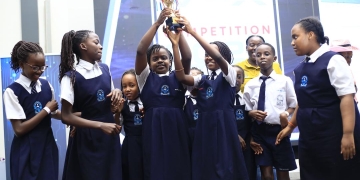
(PHOTO/File)
Some parents are still confused or ignorant about the new secondary school curriculum, despite two years in its running. Betty, a mother of three secondary school-going children, is still apprehensive of the new changes.
“I do not understand this new curriculum. I do not understand what they are teaching our children. I hear it is no longer as competitive as it was during our days,” she says with a worried look.
For some, the assessment of learners is very confusing. The grading system was changed and reading a lower secondary school learner’s report feels like reading an academic article. Just like Betty, many parents are struggling to understand how the new curriculum actually works.
In February 2020, the New Lower Secondary School Curriculum (NLSC) was rolled out in a phased approach, starting with Senior One. The curriculum aims at improving the quality and relevance of secondary education and ensuring that post-primary students are armed with skills needed in the workforce.
Gaps in the old curriculum
According to a “Brief on the lower Secondary Curriculum” posted by the Uganda Media Centre Blog on February 12, 2020, the old curriculum, designed by colonialists, was knowledge-based with little emphasis on skills and values. It thus, has been overtaken by new realities that need to address the social- economic needs of the country currently.
Its content was overloaded with a multiplicity of overlapping subjects, making it expensive to implement. It also focused on book-learning as opposed to masterly of competencies.
The old curriculum focused on academic achievement and promotion to the next class, which left out many learners. Examinations and the grading system did not cater for a wide range of abilities and many learners did more of cram work.
Textbooks were overloaded with content which favours learners with high reading abilities and the old curriculum was not in line with international benchmarks in key learning areas. With the explosion of sciences and technology, the old curriculum needed to be overhauled.
In a bid to achieve Sustainable Development Goal number four, which “ensures inclusive and equitable quality education and promotes lifelong learning opportunities for all,” The Ministry of Education and Sports reviewed the curriculum.
The new curriculum is intended to produce a secondary school graduate, who has the competencies required for employability in the 21st-century job market. Employers are looking for knowledge, understanding, skills, values, and a positive attitude.
It will also reduce the number of subjects done and contact hours in the classroom, to create time for research and project work, talent development, recreation, and creativity.
Changes in the new secondary curriculum
From knowledge-based to competence and skill-based through developing the ability to use knowledge rather than just acquiring it, the new curriculum points out the key learning outcomes;
Individuals who can demonstrate self-motivation, and self-management and know their own preferences, strengths, and limitations. They should be responsible and patriotic citizens, who cherish values, and apply environmental and health awareness when making decisions.
Life-long learners who can direct their own learning, seek opportunities for personal and professional development, be positive contributors to society, and demonstrate knowledge of emerging needs of society.
Emphasis on values adapted from the National Ethics and Values Policy 2013, such as respect for humanity and environment, honesty, justice, hard work, self-reliance, integrity, and innovativeness. The new curriculum will foster critical thinking skills, communication, cooperation and self-directing learning, mathematical computing, and ICT proficiency.
Learners will appreciate the connection between subjects and the complexities of life such as environmental issues, health awareness, and life skills.
Classroom teaching has been reduced to five hours a day from 8:30 am to 2:55 pm to allow for research, self-study, and recreation. The number of subjects has reduced from 43 to 21.
Kiswahili, Entrepreneurship, Religious Education, and Physical education are compulsory for learners at Senior One and Two. A school is expected to offer 12 subjects at Senior One and Two, out of which 11 are compulsory, while one is elective.
At Senior Three and four, a learner is expected to exit with a minimum of eight subjects and a maximum of nine subjects.
The curriculum is accommodative
In the new curriculum, all learners are winners. Gifted learners will benefit from high-order thinking exercises while slow learners will benefit from peer interactions with gifted learners
The old curriculum was competitive in nature and assessments aimed at realizing the best student. The new curriculum is accommodative as it provides room for skills development for every child across the board.
It seeks to find out whether a child has gained knowledge, understanding, skills, values, and attitudes for the world of work. The new curriculum is also learner-centered.
Assessment criteria of the new secondary curriculum
According to Ms. Ngamita Pauline Pakwo, a trainer of trainers of the new secondary curriculum, the new secondary school syllabus provides three chapters to be covered each term in every subject.
Students are given an activity of integration at the end of every chapter or topic. The marks are added and converted to 10 at the end of the term. Students also choose at least two projects from the three chapters covered every term, with the guidance of the teacher. Project marks are also added and converted to 10.
At the end of the term, a learner has 20 percent. The termly marks are kept by schools till the end of the year and converted to 20 percent.
In senior three, schools will register the learners for assessment of practical skills with the Directorate of Industrial Training (DIT).
At the end of year four (Senior Four), they sit examinations by UNEB that will be marked out of 80 percent.










